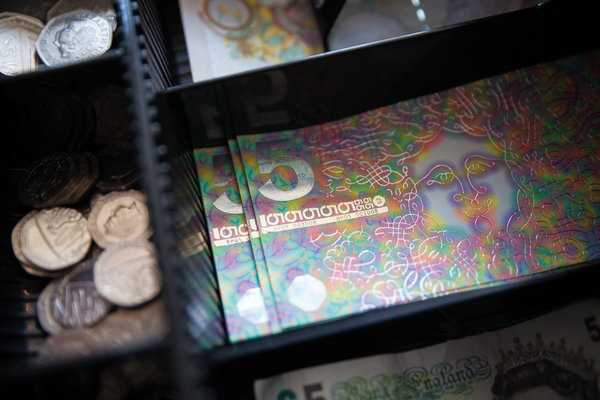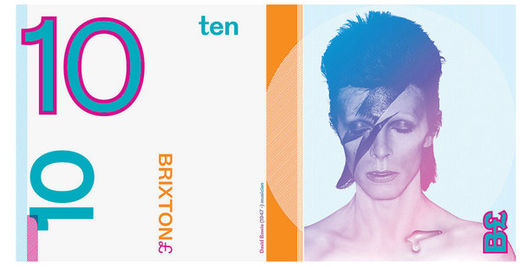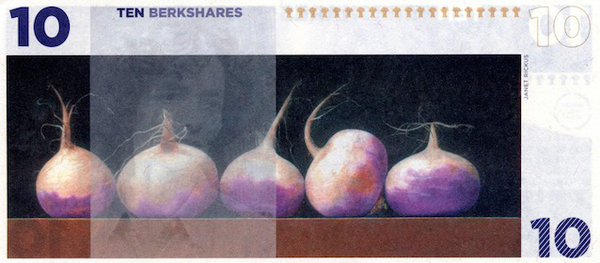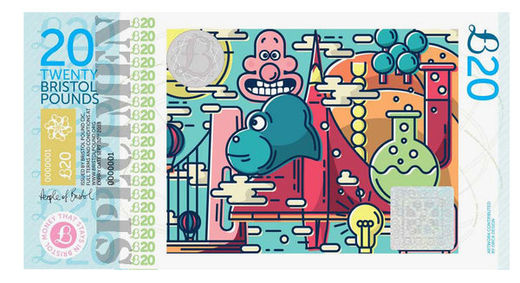
One hundred and twenty miles west of Brixton, in the city of Bristol, a pound note issued after a design competition that was open to locals displays a colorful lemur striding atop a vibrant cityscape. The back has magenta-hued, hand-cut stencil illustrations of accomplished denizens, including the author J. K. Rowling and Dr. Elizabeth Blackwell, the first woman to receive a medical degree in the United States.

These are small-batch currencies designed by locals and lovingly handled by millennials, who came of age during the rise of the Internet, the meltdown of the stock market and Edward Snowden's National Security Agency revelations, and would be forgiven for becoming more wary of credit and debit cards. Many are already opting for standard paper money over plastic (when not resorting to freeganism or bartering, that is).
Once a marker of a business with suspicious tax practices, the phrase "cash only" has come to signify hipster entrepreneurialism at places like Stumptown Coffee at the Ace Hotel in Midtown Manhattan or the Emerson Bar in Brooklyn. The term even arrived as a motto on a 3.1 Phillip Lim tank top sold by the boutique Blue & Cream (and now that it's been marked down 50 percent to $97.50, you won't need a suitcase of bills to pay for it).
Many of the new alternative currencies have the look and feel of the regular legal tender accepted at such places. Most include anticounterfeiting measures like holograms and serial numbers. But they are more eye-catching.
At the Effra Social, a Brixton pub, Ewan Graham, 31, an architect, was impressed upon examining one of the district's special pound notes for the first time. "I'd be more inclined to save money if it all looked like that," he said.
The back of the note displayed a Karl Marx quote about capital and its "occult ability to add value to itself." The £10 note, meanwhile, pictured David Bowie, a Brixton native (stardust, or other powdery substance, not included). It's easy to imagine such notes being fetishized as audiophiles do vinyl.
The local currency, though, is intended not as collectible but to encourage trade at the community businesses where they are accepted, rather than chain stores, where money taken in tends to flow out of town and into the coffers of multinational corporations. (Compare it to the farmers' market: Homegrown lettuce now has a whole new meaning.)
"If you use a local currency, you keep the money local, and that has a 'lifts all boats' vibe to it," said David Wolman, the author of The End of Money.
Unfortunately, Mr. Wolman noted, farmers' markets are an easier sell to consumers. "You have to work really hard to teach people what on earth your alternative currency is and convince them to jump on board, whereas anyone driving by a farmers' market will be like, 'Oh, look, some fresh strawberries!' "

The bills themselves are adorned with pastoral landscapes, cavorting native fauna and still-life paintings of turnips, evoking the bucolic scenery of the region.
"The idea of creating a currency that has our landscape and has our values right on the bill, that's creating a sense of place that we don't always have in America," said Alice Maggio, the program coordinator of BerkShares Inc. "Particularly as we move towards a more globalized and homogenized culture."
Their introduction coincided with the rise of Etsy and the introduction of books like The Omnivore's Dilemma by Michael Pollan in 2006, and Animal, Vegetable, Miracle by Barbara Kingsolver in 2007.
"BerkShares allowed that idea of buying local to crystallize," Ms. Maggio said. "I think people are drawn to them for the same reason they're drawn to handmade things and local food."
And one need look no further than the argument about which woman should be depicted on the new $10 bill to realize that the symbolic and aesthetic value of paper currency can be nearly as meaningful to consumers as its quantified worth.
"When some people hold a bank note, it makes them furious about fiat money and the debt," Mr. Wolman said, "but for others, those symbols embedded in that paper mean a lot — the note conjures feelings of togetherness or nationalism — and the state wants you to have that feeling."
One perhaps surprising alternative-currency enthusiast is the former central banker Bernard Lietaer, who was an architect of the European Currency Unit, the convergence system between 12 currencies that led to the euro. Now a professor of money and sustainability at the Sorbonne in Paris, he believes that money is "an extraordinarily emotional object," the immense power of which he likens, psychologically, to sex. Alternative currencies, he suggested, provide an "implicit incentive: I want to give priority to — and I'm willing to make an effort for — my region or community."
One reason that secondary currencies are appealing to currency experts like Mr. Lietaer is that they have the potential to influence spending patterns, just as frequent-flier miles encourage airline loyalty. Mr. Lietaer pointed to the Chiemgauer, a complementary currency that began in 2003 in Bavaria, Germany, as an example.
"It functions the same as the BerkShare, but with a bigger impact," he said. "They're specializing in organic food and cheese. So I buy Chiemgauers with euros, but I know these currencies will circulate in my community, specifically with organic products, and this gives motivation to produce more and have more organic producers."
Since its debut, according to the organization in charge of the Chiemgauer, 14 million euros have been exchanged into the currency, which operates in both cash and electronic formats.
Mr. Lietaer suggested that Greece, currently in bailout talks, should create a complementary electronic currency that could be accepted for the payment of taxes and usable on a local basis. This secondary currency, which he called a "neo-drachma," could be usable via mobile phone ("every Greek family has at least one," he said) to purchase local goods and services, and could fluctuate against the euro.
"If a Greek person wants to buy a German car, he would have to buy it in euros, at the exchange on the currency that's accepted with the euro," Mr. Lietaer said. "At the same time, for a haircut? I don't see any reason to use euros."
Regardless of whether it can solve major debt crises, there is an appeal to smaller, homespun, physical money, starting with the greater privacy it affords.
"As the government and corporations try to soak up more information from consumers, there are still going to be people that adhere to the good old medium of handing over dollar bills to exchange for goods and services," said John Bush, 31, a so-called liberty activist and the owner of Brave New Books in Austin, Tex.
"More people want to move away from mediums where the government can track your every purchase," he said, adding that he prefers Bitcoin, barter or precious metals, though his store does accept credit cards.
Nonetheless, the use of traditional paper money is clearly on the wane. Perhaps these smaller, more attractive artisanal paper notes are merely last bursts of glory before it disappears entirely.
Though as Mr. Deller, the artist behind the latest Brixton pound, said, "As long as there are drug deals and criminality, there'll be a need for cash."




Talk about breaking the chains !!!!!!!